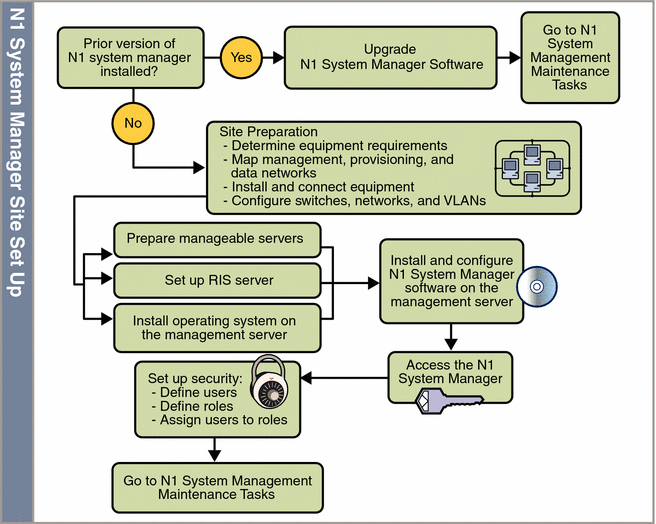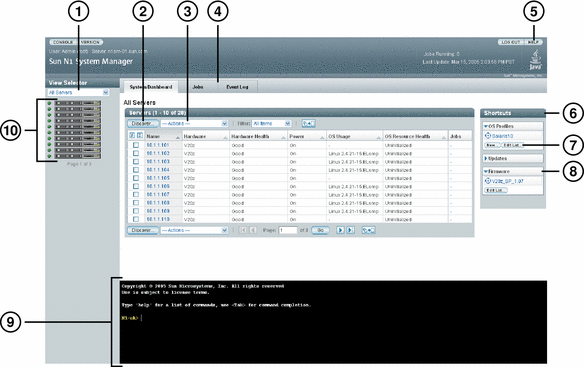N1 System Manager Installation and Configuration
This section provides a task flow diagram of the high-level tasks for site planning, installation and configuration of the Sun N1 System Manager software, and summaries of each of the tasks, including links to the applicable manuals and procedures.
The following topics are discussed:
N1 System Manager Site Preparation Task Flow
The following diagram illustrates the sequence of the high-level tasks for site planning, installation and configuration of the Sun N1 System Manager software.
Figure 2–1 N1 System Manager Site Preparation Task Flow

If a previous version of the N1 System Manager is installed on your management server, follow the appropriate upgrade process depending on the previously-installed version:
-
If N1 System Manager version 1.2 is installed on your management server, upgrade to version 1.3 as described in Chapter 3, Upgrading the Sun N1 System Manager Software, in Sun N1 System Manager 1.3 Installation and Configuration Guide.
-
If N1 System Manager version 1.1 is installed on your management server, you must first upgrade to version 1.2 as described in Chapter 2, Upgrading the Sun N1 System Manager Software and Provisionable Server Management Agents, in Sun N1 System Manager 1.2 Installation and Configuration Guide , and then upgrade to version 1.3.
If you have not installed the N1 System Manager software on your management server, read the following sections. Each section summarizes each site preparation task in sequence, and includes links to the applicable manuals and procedures for each.
Determine System Requirements and Map Your Network
Before you can prepare your equipment for the N1 System Manager, you need to determine your site architecture and system requirements as follows:
-
Map your network and determine the subnet addresses that you will use for the management, provisioning, and data networks.
Note –If your network is designed to use only a management network or only a provisioning network, then the N1 System Manager operates in a restricted mode when installed. N1 System Manager provides two default security roles with specific privileges assigned for the restricted mode of operation. See Managing Roles in Sun N1 System Manager 1.3 Discovery and Administration Guide and Restricted Mode Capabilities in Sun N1 System Manager 1.3 Discovery and Administration Guide.
-
Take inventory of the equipment you want to use with the N1 System Manager, and compare the inventory to the system requirements in Sun N1 System Manager Hardware and OS Requirements in Sun N1 System Manager 1.3 Site Preparation Guide.
-
To assist you in determining whether you will use one switch or two switches, review Reference Configurations in Sun N1 System Manager 1.3 Site Preparation Guide.
-
Based on the number of manageable servers installed on your N1 System Manager network, determine the management server and switch requirements.
For management server sizing guidelines, see Management Server Considerations in Sun N1 System Manager 1.3 Site Preparation Guide.
For switch sizing guidelines and worksheets, see Switch Considerations in Sun N1 System Manager 1.3 Site Preparation Guide.
Based on the above information, decide:
-
Which server will be used as the management server
-
Which operating system will be installed on the management server
-
Whether the N1 System Manager network will use a single switch or dual switch configuration
-
Which N1 System Manager networks you will use
When you have completed your site planning, connect your equipment.
The next tasks are to prepare the manageable servers, to install a RIS server if you will provision Microsoft Windows operating systems, and the install an operating system on the management server. Each of these tasks can be performed in parallel.
Prepare the Manageable Servers for Discovery
Before you can use the N1 System Manager to discover manageable servers, each manageable server must be set up as follows:
-
An IP address must be assigned to each manageable server's management port.
-
A minimum set of management processor credentials must be configured on each manageable server. The type of credential to be configured depends on the manageable server management processor and whether the manageable server has been configured with factory default credentials.
For further information, see Setting Up Manageable Servers in Sun N1 System Manager 1.3 Site Preparation Guide.
Tip –
Install an OS and the N1 System Manager software on your management server at the same time you set up your manageable servers and the RIS server.
Set Up the RIS Server
If you plan to provision Microsoft Windows operating systems on managed servers, you must set up a Remote Installation Services (RIS) server as described in Setting Up a Windows Remote Installation Services Server in Sun N1 System Manager 1.3 Site Preparation Guide. After running N1 System Manager discovery, you can provision Windows to managed servers as described in Chapter 3, Provisioning Windows Operating Systems, in Sun N1 System Manager 1.3 Operating System Provisioning Guide.
Install an Operating System on the Management Server
An operating system must be installed on the management server before you can install N1 System Manager.
-
For a list of qualified Solaris and Linux operating systems that can be installed on the management server, see Sun N1 System Manager Hardware and OS Requirements in Sun N1 System Manager 1.3 Site Preparation Guide.
-
For Solaris installation procedures, see Installing the Solaris OS on the Management Server in Sun N1 System Manager 1.3 Site Preparation Guide
-
For Linux installation procedures, see Installing the RedHat Enterprise Linux OS on the Management Server in Sun N1 System Manager 1.3 Site Preparation Guide
Each section provides disk drive considerations for the chosen operating system and guidelines for installation of the chosen operating system.
When you have completed operating system installation on the management server, install the N1 System Manager software on the management server as described in the next section.
Install and Configure the N1 System Manager Software on the Managed Server
When you have completed installing the operating system on the management server, the next step is to install and configure the N1 System Manager software on the management server. Once the N1 System Manager software has been successfully installed, you then configure the N1 System Manager for your operations environment.
The installation process probes your operating system installation to ensure all required software has been installed. If required software is not installed, the installation process notifies you and gives you the opportunity to resolve the error and then continue with the installation. For further information, see Chapter 1, Installing and Configuring the Sun N1 System Manager Software, in Sun N1 System Manager 1.3 Installation and Configuration Guide.
When you have completed installing the N1 System Manager on the management server, the next step is to configure the N1 System Manager.
-
The configuration process prompts you for the management server port that is to be used for the provisioning network. The configuration process then prompts you for the range of addresses that the management server DHCP service is to use to assign IP addresses to each managed server for the provisioning network.
-
You are then asked to configure the search domains, SMTP service, event logging, mail service, and Microsoft Windows Remote Installation Services server. For further information, see Configuring the N1 System Manager in Sun N1 System Manager 1.3 Installation and Configuration Guide.
When you have completed configuring the N1 System Manager, you should tune the N1 System Manager performance based on the number of servers that are to be managed. For further information, see N1 System Manager Performance Tuning in Sun N1 System Manager 1.3 Installation and Configuration Guide.
When you have completed tuning the N1 System Manager, the final task is to prepare the N1 System Manager for production as described in the following sections. Preparing for production requires that you log in to the N1 System Manager to set up user accounts and roles, discover and provision the managed servers, set up maintenance, and maintain the N1 System Manager.
Access the N1 System Manager
Once you finish installing the N1 System Manager software, you can access the N1 System Manager as described in Accessing the N1 System Manager Through the Command Line in Sun N1 System Manager 1.3 Discovery and Administration Guide. Both a command line and browser interface are provided. The browser interface also has an integrated command line.
The following figure provides a quick reference overview of the browser interface.
Figure 2–2 N1 System Manager Browser Interface Highlights

-
Use the View Selector menu to change between viewing all of the managed servers, the servers by health state, or the servers by group in the N1 System Manager.
-
Click the Discover button to launch a wizard that enables you to add servers to the N1 System Manager. Click the System Dashboard tab to view all discovered servers in the All Servers table.
-
Use the Actions menu to perform operations on managed servers selected in the table, such as loading (installing) software, enabling monitoring, and managing power.
-
Click the Jobs or Event Log tabs to see a listing of jobs or events in the N1 System Manager, respectively. The Jobs tab enables you to track the status of the operations and commands being performed on the system.
-
Click the Help button to launch a searchable help system that includes instructions for browser interface tasks and command line tasks, as well as the N1 System Manager glossary.
-
Drag-and-drop the software icons onto a server or server group in the table to begin the installation.
-
Click the Edit List button to change the list of software icons that appear in the Task Shortcuts pane.
-
Click the arrows to expand or collapse the Task Shortcut lists.
-
Use the command line pane to issue commands provided by the n1sh shell. Use this integrated shell to issue commands or to view the command output of operations initiated from the Actions menu or wizards.
-
To display help for a command in the command line pane, type help command where command is the command for which you want more information.
-
To display completion information for a command, type the command in the command line pane and press the Tab key. For example:
N1-ok> create os [press the Tab key] Potential matches (create os): os Create (copy) an OS distribution osprofile Create or copy an OS profile N1-ok>
-
-
Use the server icons to view power status and running jobs. Click a server icon to view the Server Details page.
See Access the N1 System Manager for more details on accessing the N1 System Manager.
Set Up N1 System Manager Users and Roles
The management server's superuser (root) account is automatically set up to access the N1 System Manager. You can also define other users and roles to manage your servers. You can set up new users at any time. The N1 System Manager provides role-based security to enable you to limit users' access to the system.
See Managing Users in Sun N1 System Manager 1.3 Discovery and Administration Guide and Managing Roles in Sun N1 System Manager 1.3 Discovery and Administration Guide for details on creating new users and the roles that enable them to use the N1 System Manager features.
- © 2010, Oracle Corporation and/or its affiliates
